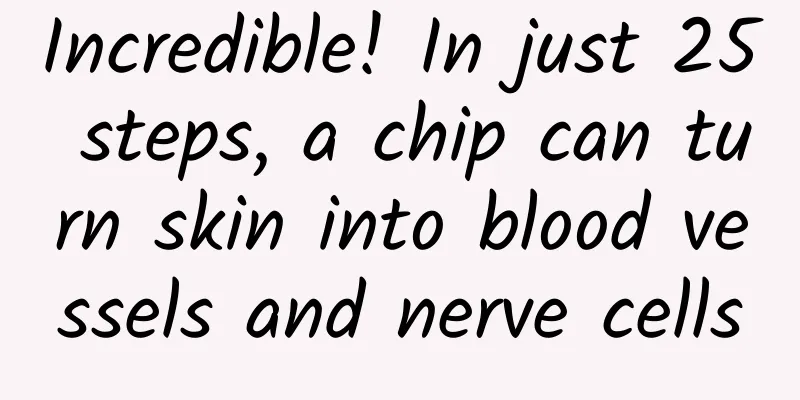Incredible! In just 25 steps, a chip can turn skin into blood vessels and nerve cells

|
Using a chip to instantly turn your skin tissue into blood vessels or nerve cells sounds too sci-fi. However, researchers from Indiana University and Ohio University have not only made it a reality, but also made the chip manufacturing technology open source. In other words, if you have the necessary medical knowledge, you can follow the instructions to make a VIP tissue conversion chip of your choice within five to six days! In this paper published in Nature Protocols, titled Fabrication and use of silicon hollow-needle arrays to achieve tissue nanotransfection in mouse tissue in vivo, scientists from Indiana University detailed this non-invasive and harmless black technology. Using electroporation technology, you can directly introduce plasmid DNA into a specific depth of mouse (or your own) skin within milliseconds to transfect the skin into blood vessels or nerve cells. Schematic diagram of nanotransfection | Source: Indiana University The authors say that the equipment required for this "tissue nanotransfection technology" (TNT) can be standardized and mass-produced. The biggest advantage of "tissue nanotransfection technology" is that it does not require the use of viruses as carriers, thereby minimizing the risk of inflammatory response and cell death. “This paper will get more people involved in regenerative medicine,” said Chanda Sen, director of the Indiana Center for Regenerative Medicine and Engineering, who invented the technology. Preparation of hollow microneedle arrays According to the "Nanotransfection" manual, changing tissue function is divided into three steps (a total of 25 specific operation links): preparing a hollow microneedle array, preparing a TNT device, and transfecting cells. The first thing to consider is which microneedle array to use. There is always a microneedle with different forms that is suitable for you. For the introduction of plasmid DNA into the local skin, the author recommends using a microneedle with a flat tip (see Figure 1A). For the introduction of deep tissue, the author recommends using a microneedle with a sharp tip to facilitate tissue penetration (see Figure 1B or 1C). Various microneedles | Source: Paper After choosing the style, we will start hand-making. First, a layer of photoresist is applied to a double-sided polished 4-inch silicon (Si100) wafer, and then the wafer is deep reactive ion etched (DRIE) using the Bosch process. Three different types of silicon hollow microneedles can be prepared according to transfection needs, including type I with a flat tip (Figure 1E, Type I), type II with a protruding tip, or type III with an eccentric hole (Figure 1F, g). The latter two types of microneedle arrays with sharp tips are more conducive to penetrating into tissues. If the diameter of the nanochannel of the needle is reduced, the speed at which the needle can output biomolecules will increase accordingly; however, this may also limit the total amount of molecules that can pass through the needle. When the nanochannel diameter is too small (250 V), the driving force will increase and a larger pore will be created in the cell membrane, which will help the delivery of plasmids. However, if the voltage is too high, it will be toxic to the cells. The authors said that the ultimate goal of this TNT chip with a silicon hollow microneedle array is to reprogram tissues. With the help of this chip, experimental mice avoided tissue necrosis in their hind limbs, and even the nerve cells transplanted into the brain improved the neurological function of stroke mice. Currently, scientists have not conducted large-scale clinical trials on humans. But after the method of making nanochips is open source, it will surely attract the interest of a large number of biohackers. Let us wait and see what kind of magical discoveries will be made at that time. References: https://www.nature.com/articles/s41596-021-00631-0 Written by: Liu Fang Editor: HS Layout: Li Xuewei Source: Academic Headlines |
>>: Made in China Day | The craftsmanship and art of a rocket
Recommend
Chaihu Shugan Pills
Medicine is very common, and different medicines ...
How to heat the lavender bear?
Lavender is a very common plant, especially in Fr...
It looks beautiful but is actually dangerous. How was the name of the new coronavirus created?
Delta has not yet left, and a new variant of the ...
What kind of Chinese medicine do you usually drink to prepare for pregnancy?
It is actually quite rare to drink Chinese medici...
The efficacy and function of the Chinese ground beetle [picture]
Traditional Chinese medicine is very helpful in t...
Why is the scent of osmanthus so difficult to replicate?
This autumn, I was wrapped tightly in the fragran...
7 Nobel Prize winners gathered at the West Lake, and the most talked about topic was whether you and I could keep our jobs.
In order to find out the reason why some strange ...
It is beautiful and long-lived, but it brings disaster to its life
Three hundred million years have passed. Since ap...
The nature, flavor and meridians of Chinese angelica
Angelica sinensis is a warm medicinal material in...
The efficacy and effects of Ayurveda[Picture]
For many Chinese people, traditional Chinese medi...
The efficacy and function of kumquat root
Kumquat root is a traditional Chinese medicine. I...
The efficacy and effects of holy basil
When it comes to holy basil, we are all familiar ...
There are traitors among us! The nervous system is not only a victim of cancer, but also a guide
The nervous system affects almost all tissues of ...
The efficacy and function of Ranunculus rotundus
There are many common Chinese medicinal materials...
[Smart Farmers] How did this plant, which is older than dinosaurs, become a "giant" in arid environments?
Your browser does not support the video tag One i...









